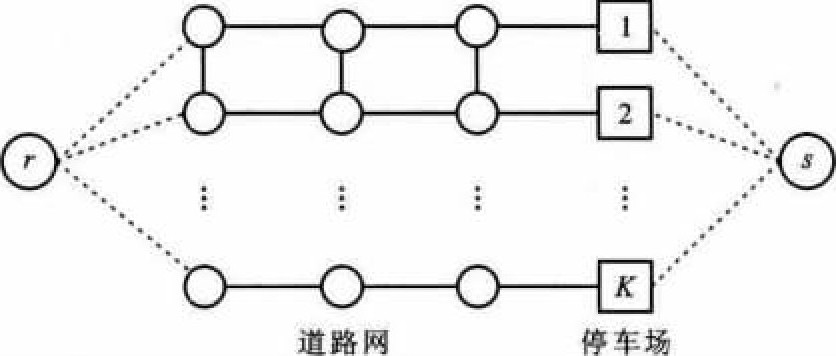Optimization model of urban parking fare based on equilibrium flow
-
摘要: 基于随机用户平衡原则, 分析了出行者的路径选择和停车选择行为, 建立了满足Logit关系的城市道路停车流量分配模型。基于收益管理思想, 以停车收益最大为决策目标, 建立了城市停车费用的双层规划模型, 并以7个节点和2个停车场的小型网络进行实例验证。分析结果表明: 当停车需求为10 000pcu·h-1时, 随着停车场2停车费用的提高, 停车流量不断向停车场1转移, 停车场1在停车费用不变的情况下收益不断增加, 当停车场2的停车费用为4元·h-1时, 总的停车收益达到最大; 当停车需求为20 000pcu·h-1时, 随着停车费用的上升, 总的停车收益将持续增加; 2个停车场之间存在博弈关系, 停车费用存在纳什均衡点, 当停车需求为10 000pcu·h-1时, 2个停车场的最优停车费用均为5元·h-1; 当停车需求为20 000pcu·h-1时, 2个停车场的最优停车费用均为最高限价10元·h-1。Abstract: Based on stochastic user equilibrium principle, the route choice and parking choice behaviors of travelers were analyzed, and the urban road parking assignment model meeting the logit relation was set up.Based on the revenue management ideology, the maximum parking revenue was taken as decision target, the bi-level programming model of urban parking fare was set up, and the example verification was carried out by using a small-size network with 7 nodes and 2 parking plots.Analysis result shows that when parking demand is 10 000 pcu·h-1, the parking flow will continue to shift from parking plot 2 to parking plot 1 with the increase of parking fare of plot 2, the parking revenue of parking plot 1 increases unceasing though its fare has no change.The total parking revenue reaches the maximum value when the parking fare of plot 2 is 4 yuan·h-1.When parking demand is 20 000 pcu·h-1, the total parking revenue will continue to increase with the increase of parking fare.On the other hand, the game relation exists betweenthe two parking plots and there is a Nash equilibrium point.In the case of 10 000 pcu·h-1, the optimal fare is 5 yuan·h-1 for the two parking plots, while the optimal fare is ceiling price 10 yuan·h-1 in the case of 20 000 pcu·h-1.
-
Key words:
- traffic planning /
- parking fare /
- bi-level programming /
- revenue management /
- user equilibrium
-
表 1 路段参数
Table 1. Road section parameters

表 2 停车场参数
Table 2. Parameters of parking plots

表 3 不同路段的计算结果
Table 3. Calculation results for different road sections

表 4 不同停车场的计算结果
Table 4. Calculation results for different parking plots

-
[1] 郭涛, 杨涛, 王瑞萍, 等. 城市停车设施规划的一种新决策方法[J]. 交通运输系统工程与信息, 2006, 6 (4): 95-99. doi: 10.3969/j.issn.1009-6744.2006.04.020GUO Tao, YANG Tao, WANG Rui-ping, et al. A new decision-making method of urban parking facilities[J]. Journal of Transportation Systems Engineering and Information Technology, 2006, 6 (4): 95-99. (in Chinese). doi: 10.3969/j.issn.1009-6744.2006.04.020 [2] 石琼, 吴群琪. 拥挤收费为主导缓解城市交通拥挤可行性研究[J]. 长安大学学报: 社会科学版, 2004, 6 (3): 38-42. https://www.cnki.com.cn/Article/CJFDTOTAL-XBJZ200403010.htmSHI Qiong, WU Qun-qi. Feasibility research on congestion pricing for our urban traf fic congestion[J]. Journal of Chang'an University: Social Science Edition, 2004, 6 (3): 38-42. (in Chinese). https://www.cnki.com.cn/Article/CJFDTOTAL-XBJZ200403010.htm [3] 裴玉龙, 刘春晓. 停车换乘站位置选择及换乘需求预测[J]. 长安大学学报: 自然科学版, 2005, 25 (1): 60-64. doi: 10.3321/j.issn:1671-8879.2005.01.015PEI Yu-long, LIU Chun-xiao. Park-and-ride station location and its demand predicting[J]. Journal of Chang'an University: Natural Science Edition, 2005, 25 (1): 60-64. (in Chinese). doi: 10.3321/j.issn:1671-8879.2005.01.015 [4] 钟慧玲, 徐建闽, 屠宇. 基于专用短程通信的停车引导和信息系统[J]. 长安大学学报: 自然科学版, 2004, 24 (2): 66-69. doi: 10.3321/j.issn:1671-8879.2004.02.016ZHONG Hui-ling, XU Jian-min, TU Yu. Parking guidance and information system (PGIS) based on dedicated short range communication (DSRC)[J]. Journal of Chang'an University: Natural Science Edition, 2004, 24 (2): 66-69. (in Chinese). doi: 10.3321/j.issn:1671-8879.2004.02.016 [5] 樊建强, 郝国瑞, 童夏. 城市道路拥堵收费的理论架构、实践效果及启示[J]. 长安大学学报: 社会科学版, 2013, 15 (4): 31-38. doi: 10.3969/j.issn.1671-6248.2013.04.006FAN Jian-qiang, HAO Guo-rui, TONG Xia. Urban road congestion charging theory, practice and enlightenment[J]. Journal of Chang'an University: Social Science Edition, 2013, 15 (4): 31-38. (in Chinese). doi: 10.3969/j.issn.1671-6248.2013.04.006 [6] GUR Y J, BEIMBORN E A. Analysis of parking in urban centers: equilibrium assignment approach[J]. Transportation Research Record, 1984 (957): 55-62. [7] PHANSAK S. Development of parking choice models for special events[R]. Madison: University of Wisconsin-Madison, 2002. [8] 严海, 杨晓光, 严宝杰. 特殊活动的停车选择模型研究[J]. 中国公路学报, 2005, 18 (2): 90-93. doi: 10.3321/j.issn:1001-7372.2005.02.018YAN Hai, YANG Xiao-guang, YAN Bao-jie. Parking choice model study for special event[J]. China Journal of Highway and Transport, 2005, 18 (2): 90-93. (in Chinese). doi: 10.3321/j.issn:1001-7372.2005.02.018 [9] 田琼, 黄海军, 杨海. 瓶颈处停车换乘logit随机均衡选择模型[J]. 管理科学学报, 2005, 8 (1): 1-6. doi: 10.3321/j.issn:1007-9807.2005.01.001TIAN Qiong, HUANG Hai-jun, YANG Hai. Mode choice models based on logit stochastic equilibrium in transportation systems with park-and-ride option[J]. Journal of Management Sciences in China, 2005, 8 (1): 1-6. (in Chinese). doi: 10.3321/j.issn:1007-9807.2005.01.001 [10] 李志纯, 朱道立. 能力约束下的停车行为模型及其求解算法[J]. 中国公路学报, 2007, 20 (5): 89-94. doi: 10.3321/j.issn:1001-7372.2007.05.016LI Zhi-chun, ZHU Dao-li. Model and its algorithm for modeling parking behavior with capacity constraints[J]. China Journal of Highway and Transport, 2007, 20 (5): 89-94. (in Chinese). doi: 10.3321/j.issn:1001-7372.2007.05.016 [11] 四兵锋, 张好智, 孙会君, 等. 能力约束条件下的城市道路及停车流量分配模型及算法[J]. 交通运输系统工程与信息, 2009, 9 (3): 78-85. doi: 10.3969/j.issn.1009-6744.2009.03.012SI Bing-feng, ZHANG Hao-zhi, SUN Hui-jun, et al. Urban road and parking assignment model and its algorithm with capacity constrain[J]. Journal of Transportation Systems Engineering and Information Technology, 2009, 9 (3): 78-85. (in Chinese). doi: 10.3969/j.issn.1009-6744.2009.03.012 [12] BELOBABA P P. Airline yield management: an overview of seat inventory control[J]. Transportation Science, 1987, 21 (2): 63-73. doi: 10.1287/trsc.21.2.63 [13] GALLEGO G, RYZIN G V. Optimal dynamic pricing of inventories with stochastic demand over finite horizons[J]. Management Science, 1994, 40 (11): 999-1020. [14] GALLEGO G, VAN RYZIN G G. A multiproduct dynamic pricing problem and its applications to network yield management[J]. Operation Research, 1997, 45 (1): 24-41. [15] FENG You-yi, GALLEGO G. Optimal stopping times for end of season sales and optimal stopping times for promotional fares[J]. Management Science, 1995, 41 (8): 941-956. [16] FENG You-yi, XIAO Bao-chun. Optimal policies of yield management with multiple predetermined prices[J]. Operations Research, 2000, 48 (3): 332-343. [17] ZHANG Dan, COOPER W L. Revenue management for parallel flights with customer-choice behavior[J]. Operation Research, 2005, 53 (3): 415-431. [18] 四兵锋, 孙壮志, 赵小梅. 基于随机用户平衡的混合交通网络流量分离模型[J]. 中国公路学报, 2006, 19 (1): 93-98. https://www.cnki.com.cn/Article/CJFDTOTAL-ZGGL200601019.htmSI Bing-feng, SUN Zhuang-zhi, ZHAO Xiao-mei. Urban mixed network flow-split model and its algorithm based on stochastic user equilibrium[J]. China Journal of Highway and Transport, 2006, 19 (1): 93-98. (in Chinese). https://www.cnki.com.cn/Article/CJFDTOTAL-ZGGL200601019.htm [19] 四兵锋, 赵小梅, 孙壮志. 城市混合交通网络系统优化模型及算法[J]. 中国公路学报, 2008, 21 (1): 77-82. https://www.cnki.com.cn/Article/CJFDTOTAL-ZGGL200801015.htmSI Bing-feng, ZHAO Xiao-mei, SUN Zhuang-zhi. System optimization model and its algorithm for urban mixed traffic network[J]. China Journal of Highway and Transport, 2008, 21 (1): 77-82. (in Chinese). https://www.cnki.com.cn/Article/CJFDTOTAL-ZGGL200801015.htm [20] 四兵锋, 高自友, 林兴强. 停车诱导信息系统条件下的城市交通网络SUE配流模型及算法[J]. 公路交通科技, 2006, 23 (1): 120-124. https://www.cnki.com.cn/Article/CJFDTOTAL-GLJK200601029.htmSI Bing-feng, GAO Zi-you, LAM W H K. Stochastic user equilibrium model for traffic assignment under parking guidance information system[J]. Journal of Highway and Transportation Research and Development, 2006, 23 (1): 120-124. (in Chinese). https://www.cnki.com.cn/Article/CJFDTOTAL-GLJK200601029.htm [21] 四兵锋, 林兴强. 交通信息条件下道路和停车选择SUE模型及算法[J]. 管理科学学报, 2007, 10 (2): 19-25. https://www.cnki.com.cn/Article/CJFDTOTAL-JCYJ200702003.htmSI Bing-feng, LAM W H K. Stochastic user equilibrium model for parking and route choice under advanced travel information system[J]. Journal of Management Science in China, 2007, 10 (2): 19-25. (in Chinese). https://www.cnki.com.cn/Article/CJFDTOTAL-JCYJ200702003.htm -





 下载:
下载:












